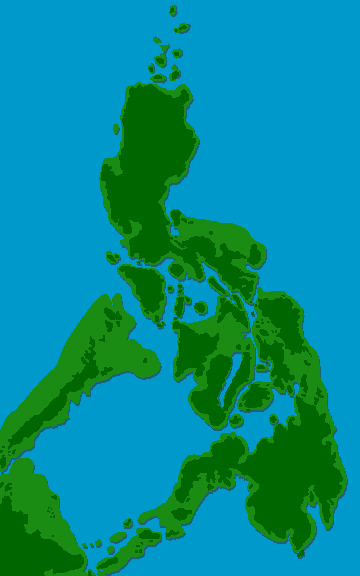Ice-Age History 2
We now know that in the Philippines, faunal regions—the natural units of biodiversity—were determined largely by the configuration of the Ice Age islands. We can map these configurations easily by drawing the shoreline as it existed about 20,000 years ago, when the seas were 120 meters below their present level. (The ancient beaches are still visible on the sea floor in some places.) An entirely new image of the Philippines then emerges: an Ice-Age island of Greater Luzon in the north that included several adjacent smaller islands; an island of Greater Mindanao in the south that included Leyte, Bohol, Samar, and many other smaller islands; and an island of Greater Negros-Panay in the center that merged Cebu, Masbate, Negros, and Panay. Dozens of other islands harbored their own unique set of species in their rain forests. As best we can tell, each of these islands remained permanently isolated from the others. The image of the Philippinesbeing composed of many distinctive sets of islands thus becomes even more robust, and the description of the Philippines as "the Galapagos Islands times ten" becomes even more apt. Every Ice-Age island in the Philippines is a unique center of diversity, even those only 250 square kilometers in area.
And so we see that roughly 80 percent of the non-flying mammals on Greater Mindanao are found nowhere else in the world. These unique species include such mammals as flying lemurs (odd creatures distantly related to bats), tree shrews (which may be ancient relatives of the primates), tree squirrels, and tarsiers (bug-eyed primates that eat lizards and large insects). On Greater Luzon, just a few kilometers away at its closest point, we see none of the species characteristic of Greater Mindanao. In their place we find giant cloud ratsthat feed on tender young leaves in the treetops, bizarre long-snouted rodents that eat almost nothing but earthworms, other rodents with black-and-white stripes, small shrew-like rodents, and a wide range of animals equally unfamiliar. At least 70 percent of the non-flying mammals on Greater Luzon are found nowhere else. Because they have been isolated from each other, each of the Ice-Age islands has its own set of strange but appealing creatures: On Greater Palawan, 48 percent of the mammals are unique; on Greater Mindoro, 44 percent; and on Greater Negros-Panay, 50 percent. For frogs, lizards, bats, birds, trees, and orchids, the story is much the same—enormous diversity composed of many isolated sets of species, each of the Ice-Age islands almost a world unto itself.
The Philippine Islands today compared to the islands during the most recent Ice Age. The modern islands are fragments of larger islands that existed from about 12,000 to 22,000 years ago. |
Original URL: http://archive.fieldmuseum.org/vanishing_treasures/Origins_3.htm

